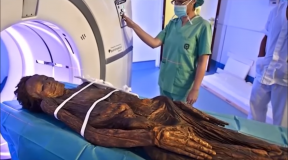by L.A. Waddell
In my recent work on British Origins, I proved by a mass of new historical evidence that the “Sumerians” those foremost civilized and civilizing ancient people whose monuments and high art of five thousand years ago are the wonder of the modern world were the long lost Early Aryans; that the Phoenicians were not Semites as has long been hitherto supposed, but Aryans and the chief colonizing branch of the “Sumerians”; and that the people who colonized and civilized India, as well as those who colonized and civilized the Mediterranean, North-Western Europe and Britain and who were the ancestors of the Britons, were likewise Aryan and belonged predominantly to the Phoenician branch of that race.
These results are now dramatically confirmed, both as regards India and the British Isles, by the discovery in the Indus Valley, a few weeks after the publication of my book, of two large series of ancient seals inscribed with Sumerian writing, unearthed from beneath the foundations of old Buddhist buildings of the third century B.C., to the second century A.D., at widely different sites on the Indus, and associated with the ancient buildings and tombs of the owners of the seals, and cultural objects of ancient Sumerian and Phoenician type.
That the writing on these seals was “Sumerian” and of an archaic type I recognized on the first glance at their photographs; and I found later that Professor Sayce and other Assyriologists had arrived at the like conclusion, but that owing to the writing being slightly different from the straight-lined script of the clay tablets, they had been unable to read a single word of the inscriptions on the seals.
On the other hand, having in my search for Aryan Origins been led by various clues to the conclusion that the Sumerian were Aryans, and devoted a great part of the last twenty years to the study of the ancient Sumerian writing at first hand, the problem of the Indus Valley script was to me a comparatively easy one. So much so that within a day or two of receiving the photographs I was able – and I say so without any wish to boast – to decipher and read the great part of the inscriptions on the seals. The subsequent weeks before going to press have been spent in revising the decipherments – which are now believed to be substantially correct – and in ransacking the Vedas and Indian Epics for the detailed references to the various famous Aryan Vedic kings, princes and priests whose names are inscribed on the seals.
The owners of several of these Sumerian seals, I soon observed, bore the names of famous Vedic Aryan seers and princes with whom I had become familiar in the Vedic hymns of the Brahmans, and some of whom were specified therein as living on the banks of the Indus. Most of the others, for fortunately all the seals are engraved with their owners names with one exception, are identified with other Vedic and Epic Aryan heroes who are disclosed as governors of a colony of seafaring Sumerian or Phoenician merchant and exploiters of the mineral wealth of the Indus Valley, and through the Ravi tributary of the latter the gold-fields of Tibet from about 3100 B.C.
The colony was founded by the famous Sumerian king of that epoch, Uruas, the Haryas’wa of the Vedas and Indian Epics, and the “Ur Nina” of Assyriologists, who I generally regarded as the first great dynasty of the Early Sumerians; and he is now disclosed to be a Phoenician, the founder of the First Dynasty of Phoenicians in Mesopotamia, and the son of the great Hercules of the Phoenicians and Greeks, here conclusively identified with the Sumerian epic hero “Gilgamesh” of Erech, and now disclosed for the first time as a historical human Aryan Sumerian Phoenician king and great Sun-priest of Bel of relatively fixed date, about 3150 B.C.
The seals are in fact the official signets and grave-amulets of the administrators with their family priests of a Mesopotamian colony in the distant Indus Valley whose very existence had been hitherto unsuspected by Assyriologists. Some of them are the official signets of famous historical Sumerian and “Akkad” kings of Mesopotamia as suzerains of the colony, including Sargon 1, who appears to have personally visited it. And the seals extend down to the end of the Ur Dynasty about 2,350 B.C., on the overthrow of that dynasty by its tributary province of Elam, when they suddenly cease, presumably owing to the colony having been lost to Mesopotamia and abandoned.
All these Sumerian and “Akkad” kings, governors and priests are duly recorded in the Vedas and Indian Epics as “Aryans”; and some of them are called “The able Paunch” which I have shown is a form of “Phoenician.” On their Indus Valley seals, several bear the title of “Aryan” and of “Phoenician” by its more common synonyms, and others call themselves “Amorite,” Goth and “Scyth,” thus confirming my discoveries announced in the former work that the Sumerians, “Akkads,” Amorites and Phoenicians were racially Aryans. Moreover, they use on their grave-amulet seals the same Sumerian sacred numeral script or “cup-mark” script, and couched in substantially the same formulas to the Sun-god as I have shown in my former work, were used by the Early Sumerians, Phoenicians, Amorites and Trojans, and by the Early Britons on their “cup marked” tombs in Ancient Britain, and thus confirming my reading of this cup-mark script on the British monuments, and the Phoenician origin of the Britons.
At the same time it is made clear that these early Aryan Sumero-Phoenicians who established and kept this colony on the Indus for about eight centuries, did not form a part of that great Aryan immigration which is now generally called “The Aryan Invasion of India.” This latter event, with its permanent occupation and systematic civilization of the heart of India, the Ganges Valley or Hindustan, I find from a mass of new evidence, took place no earlier than the beginning of the seventh century B.C., and not by sea, but overland from Asia Minor and Syria-Phoenicia, through Persia and across the Lower Indus, by a remnant of the Hittite army and Aryan Syrio-Phoenician people seeking new settlements after their calamitous defeat by the Assyrian Sargon II at Carchemish in 718 B.C.
The unique authenticity of the Indian Epic king-lists, as an independent source of Sumerian and Mesopotamian history – a discovery announced in my former work – is now strikingly confirmed by the evidence of these seals. The official Hittite origin of these king-lists, as the traditional lists of the Aryan kings from the Hittite archives back to the first Aryan dynasty in prehistoric times, and the circumstances which led to their being embedded and preserved in the Indian Epics by the Hitto-Sumerian remnant of the Aryans on their exodus to India about 700 B.C.; and my discovery that the ancient Aryan kings were Sumerians are set forth in my previous work. These Indian king-lists are now found to preserve systematically the ancestry and interrelations of the leading Mesopotamian kings and dynasties, with the original form of their names their for the period of these seals, as also of antecedent and subsequent periods, which while in part disclosed by the Sumerian monuments, are still in great part unknown or mis-known to Assyriologists, dependent as they are on isolated and fragmentary records and late Semitic, Chaldean and alien king-lists.
But the most fatal practical defect in the methods of Assyriologists disclosed by the comparison of these Indian king-list keys with the seals and with the Sumerian monuments and king-lists is that a great proportion of the names of Sumerian and Babylonian kings, gods and places, as “restored” by Assyriologists is largely and often wholly fictitious; and thus has been misleading the public and students of comparative history and religion, by disguising the personalities and racial and linguistic affinities of the Sumerians.
This inveterate defect in the restoration of the personal and place names of Sumerians by Assyriologist scholars is now seen to have arisen through the ambiguities of Sumerian being an imperial or cosmopolitan composite language, which incorporated many foreign words borrowed from the diverse speech of the many subject non-Aryan races and tribes of the Sumerian empire. For the Sumerian scribes for the most part wrote their loan-words by the same pictographic word-sign as bore their Sumerian sound-values, writing from which it resulted that the selfsame word-sign in Sumerian syllabic writing usually possesses in the glossaries many different polyglottic (so-called “polyphonous”) values, often half a dozen or more, with no indication as to which was the pure Sumerian (i.e., Aryan) value. Hence Assyriologists in “restoring” the spelling of a Sumerian proper name from its polyglottic syllabic signs into alphabetic spelling, and possessing no clue or notion whatever as to what the real phonetic form of that name was (except in a few instances where the glossaries give an unequivocal spelling), they are in the habit of selecting any one of these totally different phonetic values by mere guesswork, each scholar according to his own individual fancy. As a consequence the names thus coined at random by Assyriologists from the self same Sumerian word-signs are as bizarre as they are varied and so often fictitious.
The result of finding such vagaries in the “restored” spelling of the self same Sumerian name by Assyriologists and the haphazard cause of the same, is to dissipate all faith in the form of proper names so “restored.” For unless the Sumerian syllabic word-sign chances fortunately to possess but one phonetic value, and thus cannot be varied, which is seldom, no confidence whatever can be placed on the form and spelling of the names thus conjectureally restored.
Now, however, this fatal defect in restoring Sumerian proper names of leading kings, priests and gods, is remedied to a great extent by our Indian Epic lists of the Early Aryan kings and dynasties. These place in our hands the traditional official lists of the names of those ancestral Aryan kings and dynasties, who we find were the Sumerian and “Akkad” kings of Early Mesopotamia, with their names in the phonetic form known to and preserved by their lineal Aryan descendants. And these names for the period of these seals, as we shall see, are in substantial agreement with those inscribed on the seals and on their own monuments in Mesopotamia, although in most cases differing widely from those hitherto conjecturally “restored” by Assyriologists. These Indian Epic king lists are thus found to provide, as far as they go, a unique and the only known key to the restoration of the proper names and titles of the Sumerian and “Akkad” kings of Mesopotamia.
A striking example of the invaluable practical use of these Indian Epic king-lists in recovering the true and original form of the names and titles of Sumerian kings is furnished by its preservation of the kings’ names of the First Dynasty of Phoenicians, which founded the Indus Valley colony and some of whose seals are figured. This dynasty, hitherto considered the first concrete dynasty of the Early Sumerians, and founded by the famous “Ur-Nina, was so great, that its galaxy of inscribed monuments, sculptures, seals and other works of art and craft, and massive buildings, temples and store-houses, unearthed at Telloh (“Lagash”), the Pompeii of Early Mesopotamian antiquity,17 by M. de Sarzec during a quarter of a century, from 1877 to 1900, still forms the chief basis of our knowledge of the Early Sumerians. And it is actually taken as such by Professor Langdon in his recent historical sketch of the Sumerians in the Cambridge Ancient History, no further back than in 1923. Nevertheless, a few months later, in the same year, that Assyriologist, on finding a legendary list of Mesopotamian kings written by credulous priests of the petty and supposed alien dynasty at Isin, over a thousand years after the epoch, of “Dr Nina,” and purporting to give a complete list of the kings with their regnal years back to 241,200 years before the Flood ( ! ), accepts such a semi-fabulous list seriously, in preference to the sober testimony of the contemporary records of the historical Sumerian kings on their own monuments. And, merely because he could not find in this Isin list either the name of “Ur Nina” or those of the rest of his dynasty, or indeed of nearly all the other historical Sumerian kings, including the famous and prolific emperor Gudea, whose existing monuments make up nearly the sum-total of known Sumerian history, he throws over all these solidly-known historical kings with their monuments, and declares that they were mere impostors in calling themselves “kings” and dynasties – solely because he could not find them in his Isin list! And in this extraordinary conclusion Professor Sayce also has agreed.
But other Assyriologists may now be reassured. That inference from the Isin list is merely “a mare’s nest.” Not only are “Ur Nina” and his dynasty all there, I find, but they are made even in this Isin list the first of all “human” Sumerian dynasties in Mesopotamia, as we shall find through the Indian king-lists, though their names and titles were not recognized by the professors, mainly through having “restored” the names mostly with the wrong phonetic values. And thus one at least of the several extra thousands of years which these scholars have generously added to the date of the Sumerians in Mesopotamia, before Ur Nina’s epoch, on the strength of their reading or this list, has now got to be removed again.
It is far from pleasant for me, indebted as I am for most of my knowledge of “Sumerian” to the labors of a great body of expert scholars, to be forced to expose these serious defects in their methods and theories which stand in the way of recovering true history. But no one should be more aware of the existence of these defects than themselves. And I trust that the means now offered for remedying them will receive that fair and impartial consideration, without which it is idle to hope for any advance in our knowledge of history.
“Sumerian,” of course, is not found written on any of these seals, for this is merely another of those misleading labels which Assyriologists have arbitrarily affixed to this Aryan race. It has never once been found employed by these people themselves, nor has the word ever been found in any “Sumerian” inscription or document, yet the public have been led, or rather misled to believe that it was the genuine name of the pre-eminently civilized ancient Aryan people. Nor is the use by Assyriologists of the associated Semitic name “Akkad” any better. That name they now apply to their hypothetical “Western Semites” (who we find were Aryans), and use it to distinguish these from the decidedly non-Semitic “Sumerians”; although some years ago Professor Sayce and others habitually used it in the diametrically opposite sense, applying it to the people whom they now term as “Sumerians” and vice versa. That name however, is merely a Semitic term for the land called by “Sumerians Ari-iki or Ur-ike, ie, “Land of the Ari or Aryans” – a land the exact site of which is not yet known, but which Assyriologists suppose to be in Upper Mesopotamia, because Sargon I, whom they have dubbed a “Western Semite” called his capital “Agade,” though he never uses the term “Akkad,” nor is it found in the glossaries as a synonym for “Agade.”
Among the many Vedic priest’s and kings whose historic personalities and in part bodily relics, seals and jewelery are thus recovered and identified are Ausija (Kakshivan) Kanwa, possibly Gautam Rishi himself, and certainly “the slave-girl” Usij, the reputed consort of the latter in the epic romance. Among the kings whose historic identities and dates and monuments are now recovered, are Haryas’wa with his father and grandfather, and his descendants of the Panch-ala or Phoenician Dynasty, including especially Mudgala with his Indus Valley seal and famous stone maces, Badhryas’wa and Divo-Dasa, the emperor Sakuni or Sagara, the priest kings Gadhi, Jamadagni, Sushena and the truculent Paras’u Rama.
For the Hindus and students of Indian history, civilization and religion therefore, these discoveries must be of especial thrilling interest and importance. They disclose the actual official signets and grave-amulets of several of the most famous Vedic seers and authors of Vedic hymns, and of ancient kings and heroes whose very existence even is denied by European Sanskrit scholars, with the actual tombs of many of them containing their sacred dust. And with these are recovered for the first time the actual dates and reigns in which they lived four to five thousand years ago. We also recover through their identifications the authentic portraits of many of them from their own contemporary seals and monuments, vividly portraying their features and dress. Some of these portraits are given in the frontispiece and text, and many others in my Origin of the Indo-Aryans. As most of the seals were exhumed from the actual tombs of the saints and heroes named on the seals at their ancient Phoenician Sun-temples, these Indus Valley sites will doubtless now become popular places of Hindu pilgrimage. And it is to be hoped that the priceless seals and historical relics of these illustrious Early Aryan pioneers will be suitably safeguarded.
On the origin of the Brahmanist and Vedic religion also, much fresh historical light is shed by the seals. The early Vedic religion is disclosed as apparently a monotheism with the Sumerian Induru – the Sanskrit Indra – as the “enthroned” Father-god, with his beneficent Sun-angel Vishnu (the so-called Nina of the Assyriologists), who also assumes the dual or twin form of the Nasatya or Day and Night or Resurrecting” Sun, who is invoked for Resurrection from the Dead; and it is noteworthy that there is no trace of goddesses. The Sumerian origin and meaning of these god-names, and of the Fish incarnation (avatar) of Vishnu are disclosed for the first time-this Fish form of the Sun-angel being also found to be the Sumero-Phoenician source of the names as well as representations of the Greek and Roman sea-god Poseidon or Neptune, the Napat of the Vedas. There is also disclosed the Sumerian origin and meaning of the priestly titles “Brahman” and “Bhrigu”; the concrete evidence for the Kshattriyas or “warrior or ruling caste” having been the first Brahmans; and for the exaltation of the Brahmans to the first caste by Paras’u Rama with exact dates for these events.
The discoveries herein recorded should therefore appeal to the hearts and stir the religious and patriotic feelings of all educated Hindus who desire to know the first-found scientific proofs for the veracity of their Vedas and Ancient Epics (the Puranas), and to learn that their ancestral Vedic kings and sages were famous historical emperors, kings and priest-kings in Mesopotamia with multitudinous monuments still existing there to the present day. It must also be gratifying to the modern Hindus to find that the Vedic and Epic tradition which their ancestors preserved and handed down through the centuries, and in which they have steadfastly believed, is now proved substantially true, and has become a chief means of identifying as Aryans, the Sumerians, Phoenicians and Britons.
Besides this, it is now proved that the ancient Vedic sages and kings and people wrote and spoke in the “Sumerian” tongue – a language which is now disclosed to be the parent Aryan speech, the parent of the Sanskrit, Hindi, Maratha, Bengali, and the other Aryan dialects of India, as well as of Europe and especially of the British or “English.” Several instances of this are given in these pages, in addition to those in my former work, with reference to critical words incidentally occurring; but from an extensive survey I have found that over fifty per cent of the basic words in Sanskrit and Hindi as in Old English are clearly derived from the Sumerian. On this account, and also because the vast collection of Sumerian hymns doubtless contain original versions of many Vedic hymns, it behoves Indianists and Sanskritists, as well as the British to commence the study of “Sumerian,” in view of the new vistas thus opened up for Aryans.
For the British people, these discoveries are of prime historical importance as by confirming and further establishing the Aryan and non-Semitic origin of the Phoenicians, and their authorship of the “cup-mark” inscriptions with similar formulas on the tombs of the Early Britons, they confirm the Phoenician ancestry of the Britons as established in my former work. Thus the evidence of these seals gives fresh ground for patriotism in the glory of descent of the Britons from the originators of the World’s Higher Civilization, and therefore the foremost adventurous seamen of the Ancient World.
It would be affectation to ignore that in this and in the companion volume on British Origins, led by the new facts, I run in opposition to much of what is held to be, if not established doctrine, at any rate good working theory with regard to Sumerian, Phoenician, Indian and British history. I am also at variance with both general and expert opinion as regards the nature and causes of the so-called “Higher Civilization” I take the phrase to mean, not, as a visitor to the earth from Mars might suppose, aero planes and motors, telephones and wireless, athletics and gambling, trashy books, novels and newspapers, and a religion based largely on myths and reshuffles of the rites and superstitions of savages; but briefly, art, science and a healthy contented populace.
And as regards Origins, I find myself opposed not merely to the theorists who trace most of our culture to Judaism; but also to those who refer it to an effect, manifested rather suddenly some six thousand years ago, of the Egyptian climate on the mixed populations who at that period inhabited the Nile Valley; and also to those who look upon Civilization as arising independently amongst different races at different centers and due to a supposedly widely distributed similar temperamental strain amongst different races reacting in the very same way when exposed to the same circumstances in the early historic and later prehistoric times.
I have great pleasure in acknowledging again my indebtedness to my friend Dr Islay Burns Muirhead, M.A., for helpful criticism and remarks on some of the leading inferences. And I must express my thanks to the Edinburgh Press for the exceptional care they have bestowed on the printing of the book, with its accented oriental names and the detailed footnotes, necessary for the full authentication of the facts.
L.A. Waddell
April, 1925.
Indo-DecipheredDownload Link








5 Comments
Preface To Indo-Sumerian Seals Deciphered | CENSORED.TODAY
(November 17, 2019 - 4:24 am)[…] Go to Source Author: DissentWatch […]
markmikemays
(November 25, 2019 - 4:44 am)wow i’ve been calling myself the night-mare. cuse my dads a taurus and its my IC. im a capricorn born on the solar eclipse of jan 4 1992 and read 2 of your articles. amazing. ive been researching all day. this venus-jupiter in sag is blowing me away
Bodhi Mantra
(November 25, 2019 - 7:22 am)Ty for sopping by and commenting my friend, I hope you enjoy everything and I look forward to reading more of your comments
Bushido Bukakke
(December 23, 2019 - 10:44 pm)I’ve been trying to get a hold of you on halfchan where I saw you commenting recently. I’d really like to be a part of your Discord server if you’re still giving out invites. You can email it to me I you don’t want to post it here. May the light of the infinite Creator shine upon you.
Bodhi Mantra
(December 24, 2019 - 3:46 am)Hey my friend sure here is a link
https://discord.gg/ae6HdFh